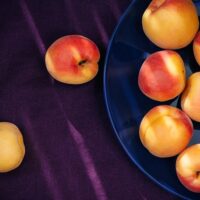A Delicate Summer Surprise
Apricots are a hidden gem of a fruit. While the delicate little apricot is not even in the running of most popular fruits in the world, it has a special charm of its own.
For those of you who are unfamiliar, they are smaller than peaches and share the tartness of purple plums.
They have been showing up frequently in my local grocery, so I decided to do a bit of research on these golden beauties.
More than 90% of the apricots grown in the United States come from California. The season runs from late April to the end of July.
Now is their time.
Of course, apricots have many nutritional benefits. 
They contain fiber, potassium, loads of antioxidants, are very hydrating, and may contribute to improved eye, skin, and gut health.
When selecting your apricots, be gentle. DO NOT SQUEEZE THEM! A light touch will tell you if they are firm or soft.
Ripe apricots yield slightly to the touch. Those that are very soft are overripe. Look for small fruit for the sweetest and best flavor.
A ripe apricot will be fuzzy and soft on the outside. It will have a deep orange or yellow hue, but you might also notice a red or rosy tinge to the skin. Those that have a green tint or are light yellow are underripe.
If they smell delicious, they probably are. They are perfect when you can break one open easily with a slight twist.
Store ripe apricots in the produce drawer of your refrigerator. If you find that they are a bit underripe, keep them at room temperature until they are just right.
Purists will enjoy these “au naturel.”
For something a bit more exciting, split them open, remove the pits and fill the soft hollow with rich strained yogurt drizzled with honey and topped with toasted, slivered almonds.
You can substitute them for peaches or plums in most recipes.
Apricot marmalade is quite a treat and makes a tasty glaze on pork near the end of grilling time. 
If you haven’t tried an apricot lately, take the apricot challenge and buy a few. The more variety we have in our diets, the better.
Cheers to trying something new,
Carol
“Five tender apricots in a blue bowl, a brief and exact promise of things to come.” –Frances Mayes





